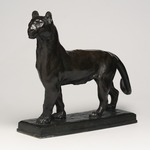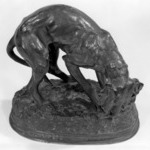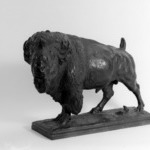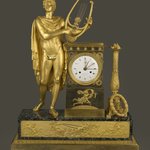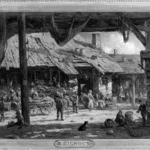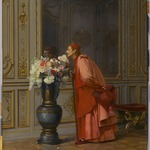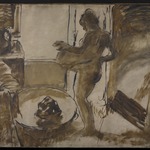
Bacchantes Embracing, Small Model (Bacchantes s'enlaçant, petit modèle)
European Art
Rodin employed skilled assistants to make reductions or enlargements of his works using a machine invented in 1836 by the engineer Achille Collas. The model to be recreated in a new size would be placed on a turntable. On a second turntable, connected to the first, would be a clay or plaster “blank,” roughly shaped to resemble the work being resized but on an enlarged or reduced scale. The machine kept the model and the blank in the same orientation while the technician used a tracing needle linked to a sharp cutting instrument (or stylus) to transfer a succession of profiles from the model onto the blank. Gradually the blank was worked so that it became a larger or smaller duplicate of the model.
This process allowed Rodin to offer popular works at a variety of prices.
This process allowed Rodin to offer popular works at a variety of prices.
CAST BY
Aage Fersing
MEDIUM
Bronze
DATES
possibly before 1896; cast after 1967
DIMENSIONS
6 5/8 x 6 1/4 x 4 1/4 in. (16.8 x 15.9 x 10.8 cm) (show scale)



MARKINGS
Lower edge near signature: "CIRE PERDUE AF"
SIGNATURE
Base, in back of figure with raised knee: "Rodin"
INSCRIPTIONS
Interior, lower edge: "4/12"
COLLECTIONS
European Art
ACCESSION NUMBER
84.77.3
CREDIT LINE
Gift of Iris and B. Gerald Cantor
EXHIBITIONS
MUSEUM LOCATION
This item is not on view
CAPTION
Auguste Rodin (French, 1840–1917). Bacchantes Embracing, Small Model (Bacchantes s'enlaçant, petit modèle), possibly before 1896; cast after 1967. Bronze, 6 5/8 x 6 1/4 x 4 1/4 in. (16.8 x 15.9 x 10.8 cm). Brooklyn Museum, Gift of Iris and B. Gerald Cantor, 84.77.3. Creative Commons-BY (Photo: Brooklyn Museum, 84.77.3_bw_SL3.jpg)
EDITION
Edition: 4/12
IMAGE
overall, 84.77.3_bw_SL3.jpg. Brooklyn Museum photograph
"CUR" at the beginning of an image file name means that the image was created by a curatorial staff member. These study images may be digital point-and-shoot photographs, when we don\'t yet have high-quality studio photography, or they may be scans of older negatives, slides, or photographic prints, providing historical documentation of the object.
RIGHTS STATEMENT
Creative Commons-BY
You may download and use Brooklyn Museum images of this three-dimensional work in accordance with a Creative Commons license. Fair use, as understood under the United States Copyright Act, may also apply.
Please include caption information from this page and credit the Brooklyn Museum. If you need a high resolution file, please fill out our online application form (charges apply).
For further information about copyright, we recommend resources at the United States Library of Congress, Cornell University, Copyright and Cultural Institutions: Guidelines for U.S. Libraries, Archives, and Museums, and Copyright Watch.
For more information about the Museum's rights project, including how rights types are assigned, please see our blog posts on copyright.
If you have any information regarding this work and rights to it, please contact copyright@brooklynmuseum.org.
RECORD COMPLETENESS
Not every record you will find here is complete. More information is available for some works than for others, and some entries have been updated more recently. Records are frequently reviewed and revised, and we welcome any additional information you might have.




